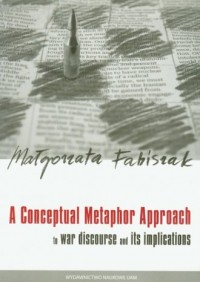A Conceptual Metaphor Approach to war discourse and its implications
Małgorzata Fabiszak

| Dane szczegółowe: | |
| Wydawca: | Wydawnictwo Naukowe UAM |
| Oprawa: | miękka |
| Ilość stron: | 270 s. |
| Wymiar: | 170x240 mm |
| EAN: | 9788323217640 |
| ISBN: | 978-83-2321-764-0 |
| Data: | 2009-09-30 |
Opis książki:
Książka łączy teorię metafory konceptualnej, analizę dyskursu i językoznawstwo korpusowe. W pierwszej części analizie poddano język reportaży wojennych prasy polskiej i brytyjskiej na przestrzeni 20 lat (1982-2001). W części drugiej wypracowano metodę rozpoznawania i nazywania domen źródłowych metafor konceptualnych na podstawie frekwencji ich różnych użyć w korpusie językowym. Książka przeznaczona jest dla badaczy i studentów językoznawstwa, dziennikarstwa i języka mediów.
This is a study analysing the language of the Polish and British press reports on war. The analysis is conducted within the Conceptual Metaphor Theory (CMT) with the aim of elucidating the role of conceptual metaphors in the structure of discourse. The comparison between the Trybuna Ludu and The Times uses of linguistic structures over the span of 20 years have shown that the rhetorical strategies, such as the vilification of the enemy, are motivated by the same conceptual metaphors regardless of the language. There are, however, certain differences in the perspectives taken within the metaphorical scenarios. The qualitative analysis of data has also made it possible to compile a frequency list of words common in the lexical field of war. These words have often been considered as indicators of the x IS WAR conceptual metaphor. A quantitative analysis of the frequency of the basic senses of these words, though, points to the fact that some of them may be activating other domains. These findings have theoretical implications for CMT, as they provide a corpus-based tool facilitating the identification and labelling of the Source Domains of conceptual metaphors underlying linguistic expressions.
Książka "A Conceptual Metaphor Approach to war discourse and its implications" - Małgorzata Fabiszak - oprawa miękka - Wydawnictwo Naukowe UAM.
Spis treści:
Style conventions
Introduction
Chapter I. Conceptual metaphor and its implications for discourse
1. Introduction
2. Conceptual Metaphor Theory
2.1. The early formulation
2.2. Further development of CMT
2.3. The criticism of Conceptual Metaphor Theory
2.4. Generic metaphors and the Great Chain of Being
2.5. Metaphor from a functional perspective
2.6. Linguistic and conceptual metaphor - a terminological problem
2.7. Conceptual Metaphor Theory and Discourse Analysis
2.8.The systemization of metaphors
3. Idealized Cognitive Models
4. Image schemata
5. Force dynamics
6. Blending Theory
7. Axiological semantics
8. A summary of the chapter and an outline for the analysis
Chapter II. Corpus linguistics and the language of mass media
1. Introduction
2. The beginnings of language corpora
3. Word meaning and the corpus
4. The language of the mass media, discourse analysis and metaphor
5. Conclusion
Chapter III. The concept of `war` in the humanities
1. Introduction
2. Clausewitz and Jomini on war
3. Philosophy and the concept of `war`
4. Social studies and the concept of `war`
5. Literature and war
6. War correspondents
7. Linguistics and war
8. Summary of the chapter
Chapter IV. A qualitative analysis of war news
1. Introduction
2. Analysis of data
2.1. Trybuna Ludu on the Falklands war (1982)
2.1.1. Paragraph-structuring metaphors
2.1.2. Isolated metaphors
2.1.3. Other rhetorical strategies
2.2. The Times on the Falklands war (1982)
2.2.1. Isolated metaphors
2.2.2. Other rhetorical strategies
2.3. Trybuna Ludu on the American air raids on Libya (1986)
2.3.1. Paragraph-structuring metaphors
2.3.2. Isolated metaphors
2.3.3. Other rhetorical strategies
2.4. Rzeczpospolita on the American airraids on Libya (1986)
2.4.1. Isolated metaphors
2.5. The Times on the American air raids on Libya (1986)
2.5.1. Paragraph-structuring metaphors
2.5.2. Isolated metaphors
2.5.3. Other rhetorical strategies
2.6. Trybuna Ludu on the Soviet withdrawal from Afghanistan (1988-1989)
2.6.1. Paragraph-structuring metaphor
2.6.2. Isolated metaphors
2.6.3. Other rhetorical strategies
2.7. Rzeczpospolita on the Soviet withdrawal from Afghanistan (1988-1989)
2.8. The Times on the Soviet withdrawal from Afghanistan (1988-1989)
2.8.1. Paragraph-structuring metaphors
2.8.2. Isolated metaphors
2.8.3. Other rhetorical strategies
2.9. Trybuna on the war on terror
2.9.1. Isolated metaphors
2.9.2. Other rhetorical strategies
2.10. The Times on the war on terror
2.10.1. Paragraph-structuring metaphors
2.10.2. Isolated metaphors
3. A summary of the qualitative-analysis of war reports
Chapter V. Words from the lexical field of war and their metaphoric potential. A corpus-based analysis
1. Introduction
2. The data
3. The British National Corpus
4. The Pragglejaz Procedure
5. The analysis of concordance lines: Frequency of literal and metaphorical uses
5.1. ATTACK
5.2. BOMB
5.3. CONFLICT
5.4. DEFEND
5.5. FIGHT
5.6. INVADE
5.7. SURRENDER 6. Summary of the
results and conclusion
Conclusion
Appendix 1
Appendix 2
Index of conceptual metaphors and metonimies
Index of authors
References
Streszczenie [Summary in Polish]

